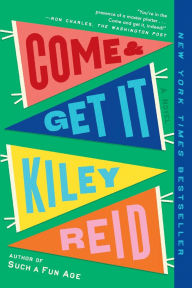Came and Got It: A Guest Post by Kiley Reid
From the author who debuted with the brilliant Such A Fun Age comes another incisive and empathetic novel that bandies with real-world themes of race, class and privilege with equal parts wit and heart. Read on for an exclusive essay from Kiley Reid on writing Come and Get It.
Come and Get It (GMA Book Club Pick)
Come and Get It (GMA Book Club Pick)
By Kiley Reid
In Stock Online
Paperback
$16.00
$19.00
Acclaimed author Kiley Reid’s fresh and provocative story about desire, consumption, and bad behavior.
Acclaimed author Kiley Reid’s fresh and provocative story about desire, consumption, and bad behavior.
There’s a quote that I place at the top of any syllabi that I hand to my students on the first day of class. It’s by James Baldwin and it reads, “You never get the book you wanted, you settle for the book you get.” I love a dark start, I’m a literary realist, and I like to approach the page as a place where perfection is attainable. It isn’t of course, as we are humans, and we continue change while our art remains, but that insistent longing is where I often find the brightest turns. In the shower, out for a walk, mostly in the middle of the night.
I’m a mother now and time is now shaped by the age of my daughter. Come and Get It was released when she was eighteen months. Now, as the paperback release approaches, my daughter is freshly three. Like all of my work, looking back, there are several little things that I would change if I could (This is why I’ll never get a tattoo). But ‘the book you get’ isn’t just the book you write. It is highly determined by the read it receives; an at once singular and communal experience happening far away from author. I deeply believe in James Baldwin’s sentiment, and that consistent longing that never leaves an artist. I also know first-hand that the book you get can often surpass your expectations and leave you with revelations that surprise and delight.
The first that stands out has everything to do with Kennedy. I began writing Kennedy as a wildcard third point of view that was meant to pop up three times in the novel and quickly disappear in to the campus crowd. But Kennedy lingered on my mind, particularly the things she did alone in her room, the activities she deemed as ‘gross.’ And so, she became more of a central character who was defined by her isolation and failed attempts to start over. Kennedy is someone for whom her longing measured equal to that of her inability to execute. She becomes socially paralyzed in terms of what she should do or say, and she just wants to go to Target and hang out with her mom. On book tour, Kennedy was the name mentioned to me most often. Young women completely understood her fear of doing simple things, like showing up to a party by yourself, or purchasing a comforter that’s uncool and embarrassing. It was a complete delight to connect with readers about the madness of going to a new place as a young adult. I was and remain grateful that Kennedy’s loneliness allowed readers to go back in time with clarity, and to share those memories with book clubs and friends.
The second thing that Come and Get it gave me was a new admiration for caregivers as readers. My first book, Such a Fun Age, focused around Emira, a young domestic worker. Come and Get It centers around Millie, a Resident Assistant at the University of Arkansas. It’s clear that I have a fascination with work culture, particularly that of workers who are meant to show genuine affection and warmth, often for very little pay. And it’s now clear to me that there is a pipeline between those who choose caregiving as a profession and those who can effortlessly open their minds to connect with fictional worlds. There’s an organizing principle that caregivers have. They can hold so much space in their brains for the patients and students and charges. My book tour events were filled with people who had once comforted students in their dorm rooms or volunteered at nurseries. I’m convinced that the brain space of a caregivers is quite cavernous and warm. They make for the absolute best readers when they aren’t caring for everyone else.
And lastly, Come and Get It revealed to me that the campus novel is a prime conduit for mother / daughter connection. I’ve truly lost count of the mother / daughter pairs that came to my readings, many of whom told me that this was their first joint book club book, and that it certainly wouldn’t be the last. Perhaps the campus novel provides equal footing for both sides; nostalgia and clarity for mothers looking back and dread that mimics excitement for those embarking on adulthood. Come and Get It in particular showcases mothers and daughters in varying levels of dependency, and the trajectory of independence is anything but linear. Right now, my daughter is mostly reading picture books, which is very enjoyable in its own right. But the release of my second novel, and the mothers and daughters who supported it, have potentially added a bright layer of dimension for what I’ll experience with my own daughter one day. I’m forever grateful to the readers of my work, particularly a second novel which is no easy feat, and I hope that the paperback release reaches the many other similar readers. Lovely, thoughtful, caregiving people who just want to go to Target or hang out with their moms.
